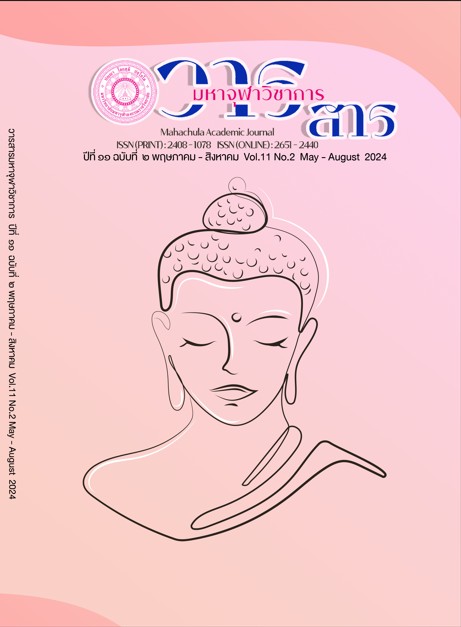An Analytical Study of the Enlightenment of the Foremost Bhikkhunis in Theravãda Buddhism : A Case Study of Kĩsa Gotami, Patฺãcãrã and Kunฺdฺalakesĩ
Main Article Content
Abstract
In this paper, three objectives were purposely made: (1) to study the enlightenment in the scriptures of Theravada Buddhism; (2) to study the history of Kĩsa Gotamĩ, Patฺãcãrã, and Kunฺdฺalakesĩ who were given the foremost in Theravada Buddhism; and (3) to analyze the enlightenment of Bhikkhunĩs who were given the foremost in Theravada Buddhism by which a case study of Kĩsa Gotamĩ, Patฺãcãrã, and Kunฺdฺalakesĩ was purposively chosen. This research employed the documentary research methodology done by studying the exceptional examples of the mentioned three Bhikkhunĩs who were given the foremost out of thirteen ones and then the contents analysis was also done through the descriptive method respectively.
The research findings showed that: 1) the enlightenment in Theravada Buddhism is defined as enlightenment in the level of Lokuttara-dhamma (nine supermundane states), comprising of four kinds of Magga (the four paths), four kinds of Phala (the four fruitions), and Nibbãna accordingly. In these states, through insight and tranquil meditation, the noble ones are able to get rid of tanฺhã (craving), kilesa (defilements), and samฺyojana (fetters), and thereby realizing Ariyasacca (the four noble truths), 2) the history of Therĩs, Kĩsa Gotamĩ, Patฺãcãrã, and Kunฺdฺalakesĩ who were given the foremost in Theravada Buddhism shows that in the time of the Buddha named ‘Patumitta’ they had the intention to ordain and thereby wishing to be given the foremost and their wish was complete in the time of Gotama Buddha, 3) in analyzing the enlightenment of Bhikkhunĩs who were given the foremost in Theravada Buddhism, it also shows that Kĩsã Gotami became enlightened through contemplation of the flickering lights and received the title Lũkhacĩvaradharãnamฺ (foremost wearers of coarse robes); Patฺãcãrã became enlightened through contemplation of the water that she used to wash her feet three times and received the title Vinayadhãrikã (foremost keeper of the monastic disciplinary rules among the nuns), and Kunฺdฺalakesĩ became enlightened through contemplation of flowing water and received the title Khippãbhiññã (foremost nun in quick deep knowledge). The extraordinary qualities of the three Therĩs were of four kinds of Patฺisambhidã (the four ways of discriminating knowledge), eight kinds of Vimokkha (the eight states of liberation), and six kinds of Abhiññã (the sixfold super knowledge).
Article Details

This work is licensed under a Creative Commons Attribution-NonCommercial-NoDerivatives 4.0 International License.
References
จุฑาภัค หริรักษ์ธำรงค์. “รูปแบบการบรรลุธรรมในพระพุทธศาสนาเถรวาท”. ดุษฎีนิพนธ์ปริญญาพุทธศาสตรดุษฎีบัณฑิต. บัณฑิตวิทยาลัย: มหาวิทยาลัยมหาจุฬาลงกรณราชวิทยาลัย, ๒๕๖๐.
ดำรง ศิรโกวิท และคณะ. “สถานะและบทบาทของภิกษุณีในพระพุทธศาสนาเถรวาทของสถาบันสงฆ์ไทย”. วารสารวิชาการสถาบันพัฒนาพระวิทยากร. ปีที่ ๖ ฉบับที่ ๒ (เมษายน-มิถุนายน ๒๕๖๖): ๑๗๓.
พระประสาน ชยาภิรโต (อร่ามวาณิชย์). “กระบวนการบรรลุธรรมของพุทธสาวิการในพุทธปรัชญาเถรวาท”. วิทยานิพนธ์ศาสนศาสตรมหาบัณฑิต สาขาวิชาพุทธศาสนาและปรัชญา. บัณฑิตวิทยาลัย: มหาวิทยาลัยมหามกุฏราชวิทยาลัย, ๒๕๖๓.
พระปลัดเดโชว์ สุคนฺโธ (ไทยมานิตย์). “ศึกษาการบำเพ็ญบารมีและการบรรลุธรรมของพระปฏาจาราเถรี”. วิทยานิพนธ์พุทธศาสตรมหาบัณฑิต. บัณฑิตวิทยาลัย: มหาวิทยาลัยมหาจุฬาลงกรณราชวิทยาลัย, ๒๕๕๘.
พระพรหมคุณาภรณ์ (ป.อ. ปยุตฺโต). พุทธธรรม ฉบับปรับขยาย. กรุงเทพมหานคร: สำนักพิมพ์ผลิธัมม์, ๒๕๕๕.
พระมหาสังเวย ธมฺมเนตฺติโก (เนตรนิมิต). “การศึกษาเชิงวิเคราะห์เรื่องชีวิตภิกษุณีกับการบรรลุอรหัตผล: เฉพาะที่ปรากฏในเถรีคาถา”. วิทยานิพนธ์พุทธศาสตรมหาบัณฑิต สาขาวิชาพระพุทธศาสนา. บัณฑิตวิทยาลัย: มหาวิทยาลัยมหาจุฬาลงกรณราช วิทยาลัย, ๒๕๓๖.
พระมหาอธิวัฒน์ ภทฺรกวี (บุดดานาง). “การสร้างและปรับเปลี่ยนอัตลักษณ์ผู้หญิงภิกษุณีในอรรถกถาธรรมบท”. วารสารวิชาการธรรมบททรรศน์. ปีที่ ๒๑ ฉบับที่ ๒ (เมษายน-มิถุนายน ๒๕๖๔): ๑๒๖-๑๓๐.
มหาจุฬาลงกรณราชวิทยาลัย. พระไตรปิฎกภาษาไทย ฉบับมหาจุฬาลงกรณราชวิทยาลัย. กรุงเทพมหานคร: โรงพิมพ์มหาจุฬาลงกรณราชวิทยาลัย, ๒๕๓๙.
แม่ชีกฤษณา รักษาโฉม. “การศึกษาเชิงวิเคราะห์บทบาทของพระวินัยธรในพระวินัยปิฎก: ศึกษาเฉพาะกรณี พระอุบาลีเถระ และพระปฏาจาราเถรี”. วิทยานิพนธ์พุทธศาสตรมหาบัณฑิต สาขาวิชาพระพุทธศาสนา. บัณฑิตวิทยาลัย: มหาวิทยาลัยมหาจุฬาลงกรณราชวิทยาลัย, ๒๕๔๕.
สมเด็จพระพุฒาจารย์ (อาจ อาสภมหาเถร). คัมภีร์วิสุทธิมรรค. กรุงเทพมหานคร: บริษัทธนาเพรส จำกัด, ๒๕๕๔.
สานุ มหัทธานาดุลย์. “การโค้ชชีวิต: มุมมองของจิตบำบัดและการให้คำปรึกษาเชิงพุทธิ”. ธรรมธารา วารสารวิชาการทางพระพุทธศาสนา. ปีที่ ๗ ฉบับที่ ๑ (ฉบับรวมที่ ๑๒, ๒๕๖๔) : ๑๕๔-๑๕๙.
สุชาดา พระเขียนทองและมนตรี สิระโรจนานันท์. “การปฏิบัติธรรมโดยการพิจารณาขันธ์ ๕ ของพุทธศาสนิกชนสตรีไทย”. วารสารมหาจุฬาวิชาการ. ปีที่ ๖ ฉบับที่ ๑ (มกราคม-มิถุนายน ๒๕๖๒) : ๑๙๗.
สุนทร สุขทรัพย์ทวีผล. “การวิเคราะห์แนวคิดเรื่องฆราวาสมุนี”. วารสารวิจยวิชาการ. ปีที่ ๖ ฉบับที่ ๓ (พฤษภาคม-มิถุนายน ๒๕๖๖) : ๓๘๐.
กรมอนามัย. COVID-๑๙ รู้ทันป้องกันได้. “สรุปสถิติทั่วโลก รายงานสถานการณ์โควิด-๑๙ ทั่วโลก”. [ออนไลน์]. แหล่งที่มา: https://www.bbc.com/thai/articles/c4n4d4225020 [๓๑ สิงหาคม ๒๕๖๖].
สำนักข่าว Amaring ๓๔ HD. ข่าวทั่วไป. “รำลึก ๑๗ ปี โศกนาฏกรรม คลื่นยักษ์ สึนามิ”. [ออนไลน์]. แหล่งที่มา: https://www.amarintv.com/news/detail/114007 [๒๘ สิงหาคม ๒๕๖๖].
สำนักข่าว BBC New ไทย. “วินาศภัยลิเบีย ทำไมความเสียหายถึงรุนแรงเช่นนี้ ในวันที่ยอดผู้เสียชีวิตอาจเพิ่มสูงถึง ๒๐,๐๐๐ คน”. [ออนไลน์]. แหล่งที่มา: https://www.bbc.com/thai/articles /cgrnp30qnzeo [๑๑ กันยายน ๒๕๖๖].


